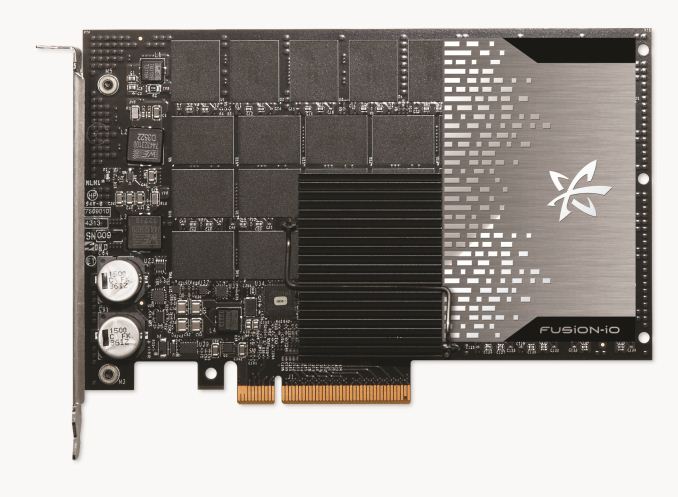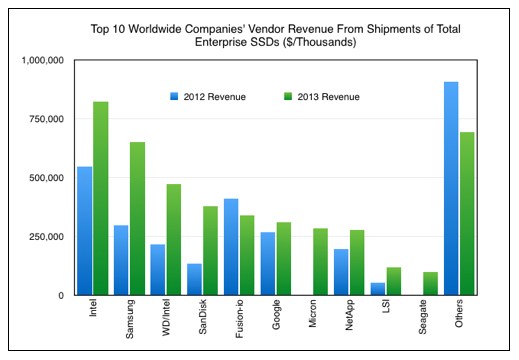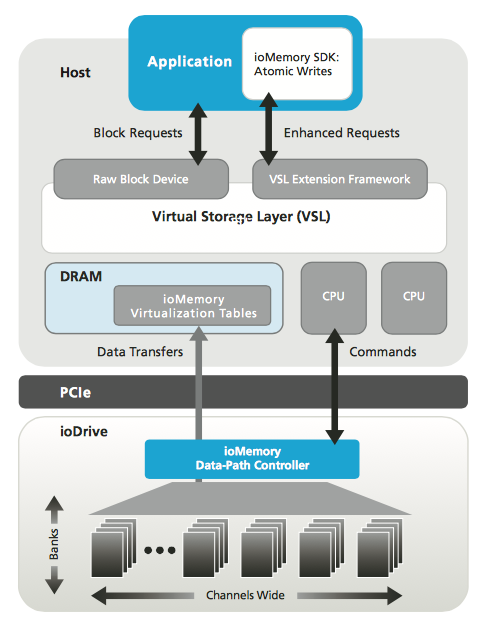The State of SanDisk
by Kristian Vättö on December 5, 2014 8:00 AM ESTThe Enterprise
In mid-July SanDisk announced their acquisition of Fusion-io and the acquisition was completed a couple of week prior to Flash Memory Summit. I posted my initial thoughts when the news hit the public, but I feel that it's worth doing a bit deeper analysis now that I have given it some more thought and discussed it with John Scaramuzzo, senior vice president and general manager of SanDisk's enterprise business.
SanDisk has managed to establish itself as one of the key players in the enterprise SSD space over the past few years. The acquisitions of Pliant in 2011 and SMART Storage Systems in 2013 provided SanDisk with strong expertise and product lineups for SATA and SAS SSDs but left the company without a solid long-term plan for PCIe. I heard Pliant's initial roadmap included plans for PCIe-based solutions as well, but it looks like those plans never materialized.
Up until the Fusion-io acquisition, the Lightning PCIe SSA was the only PCIe solution in SanDisk's enterprise product portfolio, and as a matter of fact that drive is internally a SAS-based design with a PCIe to SAS bridge onboard. In other words, SanDisk had practically zero real PCIe solutions for the enterprise, while at the same time SanDisk's biggest competitors, such as Intel and Samsung, have had PCIe drives for a long while already.
Fusion-io's 3.2TB Atomic Series SSD
Fusion-io's strategy and product portfolio, on the other hand, was a complete opposite. From the beginning Fusion-io has focused on PCIe storage, which dates all the way back to 2007 when the company released its first ioDrive that utilized a PCIe x4 interface and was capable of speeds up to 800MB/s. Not only was Fusion-io early in the market, but the company was also able to garner a few massive and very important clients – the most notable being Facebook and Apple. I don't think it's an overstatement to say that Fusion-io can be considered as the pioneer of PCIe storage because it was the first company to turn PCIe SSDs and storage in general into a large, successful business.
But stories eventually come to an end. The competitive advantages Fusion-io had were its PCIe technology and several high-level customers, but the advantages were lost when the NAND manufacturers stepped into the PCIe territory. It's nearly impossible for a company that has to source its NAND from a third party to compete against another company that manufactures NAND in-house since the latter will always have advantages in cost. While Fusion-io didn't lose its customers to competitors overnight, it's clear that especially Intel and Samsung snagged a share of Fusion-io's business in the past couple of years.
In a nutshell, the acquisition brings SanDisk the long-needed expertise in PCIe storage along with Fusion-io's broad PCIe product portfolio. The acquisition is now a bit over 100 days in and the Fusion-io employees have been integrated into SanDisk's existing teams. Initially Fusion-io's engineering team was separate and worked under Lance Smith, the former President and COO of Fusion-io, but Mr. Smith decided to leave SanDisk and pursue other options. Last week a data virtualization startup Primary Data announced that Mr. Smith has joined the company as the new CEO, which explains his quick departure from SanDisk.
All the engineering talent has now been unified and the team is lead by Mr. Scaramuzzo. With everyone under the same roof, the roadmaps are now in the process of being integrated to bring the expertise together. It will be a while before we see the fruits of the acquisition, but in the meantime the latest Fusion-io products will transition to SanDisk NAND for increased cost efficiency.
But what about NVMe? That has been the hot topic in the industry this year and I bet many of you are wondering what is SanDisk's and Fusion-io's play in that field. The short version of their strategy is that Fusion-io already has a technology called Virtual Storage Layers (VSL), which is essentially a driver/software stack similar to NVMe. The truth is that NVMe isn't really anything new from a technology perspective, but what makes it alluring for many manufacturers is the fact that the NVMe drivers are universal and already supported by the latest operating systems. Technologies like VSL are rather expensive to develop and require expertise because there is no framework available (i.e. everything has to be developed from scratch), but on the other hand an in-house driver like VSL allows for more customization and optimization.
However, that doesn't mean that SanDisk has no interest on NVMe whatsoever. The company sees that as the entry and mid-level enterprise SSDs move from SATA and SAS to PCIe, NVMe will be one of the key factors because of easy and quick deployment. For that market segment the NVMe spec and its limitations are fine – it's only the high-end segment where the benefits of VSL are more prominent. It's actually likely that many manufacturers will turn to custom NVMe drivers anyway for higher and more optimized performance, and in fact that is already happening with Intel providing its own NVMe driver for the P3600/P3700.
Lastly, let's quickly discuss the ULLtraDIMM. I wrote a quick piece on ULLtraDIMM right after Flash Memory Summit, but SanDisk has already scored Huawei as the third ULLtraDIMM partner (in addition to IBM and Supermicro). The first generation product that is currently available is internally based on a pair of SATA 6Gbps controllers, but SanDisk said that a native DDR to NAND controller is possible in the future if the market adopts the new form factor well. As usual, the industry is fairly slow in adopting new form factors, so it's hard to say whether NAND DIMMs will really take off, but it's a very interesting and potentially useful technology.
Final Words
All in all, SanDisk is definitely one of the most interesting NAND companies going forward. USB drives, eMMC solutions, SSDs and even the storage arrays from the Fusion-io acquisition are all built on NAND, which puts SanDisk in a unique position as it's the only NAND manufacturer that focuses solely on NAND products. The company can't turn to alternative revenue sources like e.g. Intel and Samsung can, but on the other hand that's also SanDisk's strength as all the know-how and experience in the company is related to NAND in one way or the other.
Ultimately next year will be crucial for SanDisk because it determines whether the company can materialize all the underlying potential from the Fusion-io acquisition and become a serious competitor to Intel and Samsung in the enterprise space. The pieces are definitely there, so it's just a matter of execution now.














132 Comments
View All Comments
MrSpadge - Friday, December 5, 2014 - link
BTW: I know this could already be done relatively easily using the libraries of Win 7/8. But I'm pretty sure most people are not using them, let alone have given relocating the corresponding storage locations a thought.Conficio - Friday, December 5, 2014 - link
I think what would work for new OEM laptops with SSD is a "SSD inside" kind of campaign with jingle and pretty face. Add a few real benefits like longer battery life and you are good to go.Or how about bundling the new SSD with online backup secure and encrypted and hassle free. May be even cold storage for life of all those pictures and documents. To get out of the big spinning rust disk vs smallish SSD? Add it some automatic download and archive of the paper-less bills and CC statements and tax returns, etc. and you are golden.
My parents or other mainstream PC users can't be convinced to "upgrade" their PC by anything until the next PC. The labor cost of servicing is just to high. They are easier convinced to buy a new laptop/PC if they can see the tangible benefits above.
oxwax - Friday, December 5, 2014 - link
One word: INFOMERCIAL. If the general public can be pursuaded to buy junk like My Clean PC to make his or her computer faster, a very well structured infomercial that actually "informs" the general public that his or her PC is hampered by the slow hard drives installed by OEM should do amazingly well. The general public does not even know that SSDs exist, let alone the benefits(60 - 120MB/s vs 300 - 550MB/s). Showing side-by-side comparisons would help. Include cloning software and ***** A FREE OPTICAL DRIVE BAY CADDY **** would almost ensure success. Could possibly be bigger than the George Foreman Grill, if correctly implemented!sheh - Friday, December 5, 2014 - link
The major improvement from SSDs is usually not the linear read speed, but the random access.oxwax - Friday, December 5, 2014 - link
I strongly agree, but we are considering the general public. Steve Jobs had it correct with the KISS (Keep It Simple Stupid) template for marketing. Have you ever sat down with a professional that has a degree in a very advanced science(like a neurosurgeon or endocrinologist), and he or she wants to explain things to you thoroughly in professional jargon? Most people get lost and tune out the conversation. The only thing that general public wants is for the product to perform as expected as easily and simply as possible with as few hiccups as possible. You can even break it down in layman's term. I like to use cars to explain computers to my clients. The CPU is like the engine, RAM is like the fuel injection, and storage are like tires. If you put cheap tires on your Ferrari, your Ferrari will only go 120 MPH. If you put the best tires in the world, your Ferrari will perform to the top of its capabilities. Adding an SSD like putting 550 MPH tires on an electric engine. Sometimes I'll even go as far as describing how having a Core i infrastructure is like having a drag strip between the RAM and CPU vs an Indy car track for Pentium processors. Everytime, people seem to appreciate that I know these things, but he or she usually begins to just state "I just want it to work like your saying." So, yes. We geeks will completely understand the finer details, but the general public just wants to KISS it!name99 - Friday, December 5, 2014 - link
"This is actually the part where we ask for your, our readers, help. What is it that we or manufacturers like SanDisk could do to boost the SSD penetration in the market? "Stop chasing benchmark speed at the expense of everything else. Streaming r/w speed is nice, yes, but it appears to be coming at the expense of other things that, for AVERAGE users are more important. This primarily means:
STABILITY/SAFETY. This is a huge one. I mean, for crying out loud, it is STILL an issue. Samsung, supposedly the safest brand in terms of firmware that works, had to release an update two months ago to resolve firmware issues. It's 2014, not 1011. This shit should not still be happening.
If the industry as a whole wants to expand, it should create some sort of "Designated as not a PoS" certification program which takes drives, tortures them in a variety of ways, and certifies that they are SAFE SAFE SAFE. They don't screw up when they lose power randomly. They don't screw up when they are running at 99% full capacity. When they DO fail, they fail by telling you that writes no longer work, and by allowing reads to access 100% of the drive so you can recover (even if you were too foolish to run a continual backup). etc etc.
And if the industry is so damn short-sighted that it insists on crippling this certification program, so that its tests aren't demanding, aren't trustworthy, are full of loopholes, well then, boo hoo --- it damn well deserves to be stuck in its current ghetto of limited sales and desperate attempts to try to grow.
After this (by far the most important) issue of stability and safety, the second most important issue is
- optimize for random r/w rather than streaming. Yes streaming is nice and you can get big studly multi-100MB/s numbers that sound good. But what actually matters for MOST users' daily performance is the random access numbers
- get the maximum power draw down. As long as the maximum power draw (usually for random writes) is over 2.5W, these devices are basically not usable as external drives because they are too dangerous to use when connected to USB2. They'll seem to work just fine, then hang as soon as a stream of writes hits them. The external drive market may not be huge, but it's not negligible either.
- The second aspect of the external market is that, where possible (which I assume means USB3) you still need to support TRIM and SMART. Just because a drive is external doesn't mean I no longer care about its performance or its longevity/safety.
Basically, vendors need to spend less time worrying about dick-measuring benchmarks and more time thinking like Apple about what is best for the average customer.
stunta - Friday, December 5, 2014 - link
> what would it take for them or other people who are not very comfortable around computers to upgrade their PCs with an SSD?Friends and family who are not tech-savvy don't know what an SSD is. Solve that problem first.
Dadofamunky - Saturday, December 6, 2014 - link
If you have an SSD, CPU speed becomes less vital to overall performance. If the BOM is 430-$50 higher with an SSD, you can easily make do with an i5 instead of an i7. Easily. Most CPU cycles on these clunky laptops are completely wasted. Fatter CPUs and spindle drives also are heat bombs in every laptop. An SSD solves all of these problems. The OEMs can keep buying their contracted Intel chips - they just get to build better-balanced cheap laptops that their users will actually like to use. I don't get why SanDisk and other companies don't recognize this.beginner99 - Saturday, December 6, 2014 - link
demonstration of same laptop one with ssd one with hdd. Both have same windows image installed and it should be a heavily used, old installation not a fresh one. Then users can compare directly how much faster the SSD laptop will be down the road in 1-2 years.dareece - Saturday, December 6, 2014 - link
To comment on the the last paragraph; the industry is not ready to offer lower performance/lower cost SSDs to the consumer market just yet (You can already purchase laptops with SSDs in limited configurations). It's all about getting as much revenue up front before selling out to the masses who always want the lowest price. The manufacturing cost associated with creating larger capacity drives and faster speeds needs to be paid for by the OEMs first to allow the overall costs to be reduced so that they can be passed on the non-OEM end-user. This is standard industry practice in the technology sector.